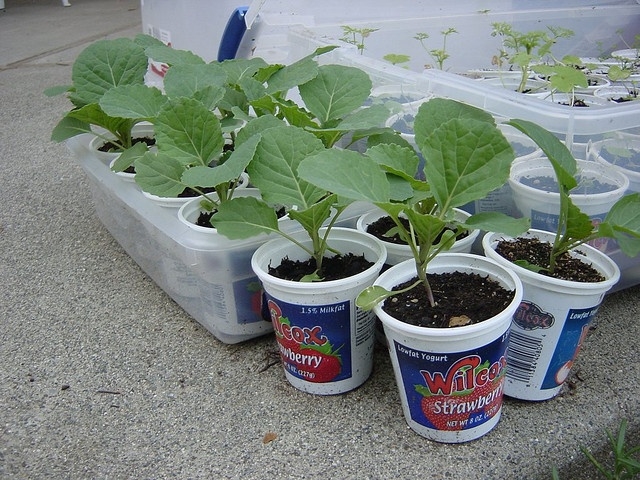 Cauliflower contains many vitamins and minerals. Recently, it has become one of the staple foods for people eager for proper nutrition. To get cauliflower at the earliest possible time, you have to grow it through seedlings. This technique complicates the technology a little, but it allows you to grow crops a month earlier.
Cauliflower contains many vitamins and minerals. Recently, it has become one of the staple foods for people eager for proper nutrition. To get cauliflower at the earliest possible time, you have to grow it through seedlings. This technique complicates the technology a little, but it allows you to grow crops a month earlier.
Content
Sowing methods
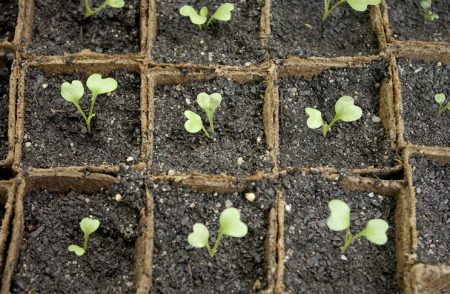 Decent seedlings can be obtained in 2 ways:
Decent seedlings can be obtained in 2 ways:
- in the usual way in boxes;
- pot method.
In the first case, the seeds are sown in boxes or a greenhouse. For the second option, pots made of different materials are used.
Young plants have very tender and weak roots. Seedlings of this vegetable will grow well only on loose, breathable soil. In this regard, the method using pots is more suitable. So the roots of the plant will be less injured.
A combination of both methods is also allowed when the seeds are sown in boxes or in a greenhouse, and then the seedlings are peaked in peat pots.
When to plant for seedlings
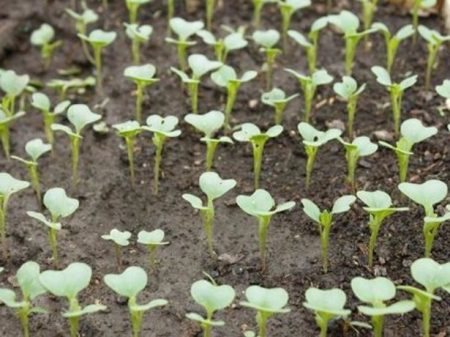 Individual vegetable growers, choosing the sowing date, are guided by the lunar sowing calendar. It is also logical to read the recommendations printed on the packaging for seeds. There, for each variety, it is indicated when it is best to sow the seeds.
Individual vegetable growers, choosing the sowing date, are guided by the lunar sowing calendar. It is also logical to read the recommendations printed on the packaging for seeds. There, for each variety, it is indicated when it is best to sow the seeds.
Seedlings grow on average 45 days. During this period of time, without deviating from technology, viable seedlings can be grown.
It is recommended to sow early varieties from March 5 to 10. Late cultivars are sown from March 10 to 20 or by the seedling method - immediately to the garden bed in early April, but under cover with a plastic wrap. For seed germination, it is enough that the temperature of the soil is from +2 to +5 degrees.
Seeding dates for the earliest harvest should be adjusted according to the growing region. In the southern regions of the country, sowing is carried out earlier than, for example, in Siberia or the Urals.
For residents of any region, there is a calculation in which it is easy to determine the timing of sowing early cauliflower. In this case, only 2 factors are taken into account:
- growing period - 45 days;
- approximate date when the soil warms up to +5 degrees.
Having made a deduction from the planting period of 45 days, we get the approximate date of sowing seeds. To harvest in August, you need to purchase early varieties of seeds for growing:
- "Movir 74";
- "Gribovskaya 1355";
- "Patriotic".
Varieties of late ripening, as usual, are sown at the end of April in a greenhouse. When sowing in this period, the crop should be expected no earlier than September.
When the shoots hatch, much attention should be paid to the temperature regime. If the thermometer begins to show more than 20 degrees, there is a likelihood that the cabbage will form a dwarf head. The same head can happen if the seedlings become deficient in moisture and light.
Preparation of land and containers
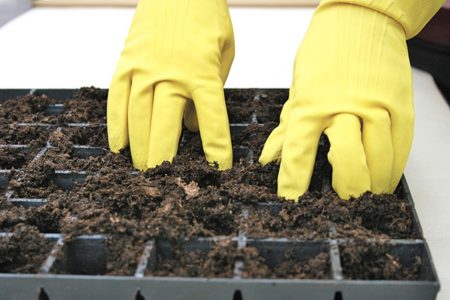 This vegetable crop is demanding on fertility and some kind of soil mixture will not suit it. The soil for it must be thoroughly prepared, otherwise the plants will feel a lack of nutrients, and the seedlings will grow weak and not viable.
This vegetable crop is demanding on fertility and some kind of soil mixture will not suit it. The soil for it must be thoroughly prepared, otherwise the plants will feel a lack of nutrients, and the seedlings will grow weak and not viable.
To make the soil in equal amounts, take the following substances:
- turf land;
- peat;
- rotted manure.
All these components are thoroughly mixed, and the mixture is placed in boxes.Then the soil is fertilized with double superphosphate, based on the calculation: 20 g per m2, and then the soil composition is disinfected, spilling it with a light pink solution of potassium permanganate.
In order to prevent the disease of seedlings with a black leg, it is necessary to prepare river sand, after calcining it on fire. It will be needed to fill the soil after sowing seeds. In extreme cases, ash can be used instead.
Seed preparation
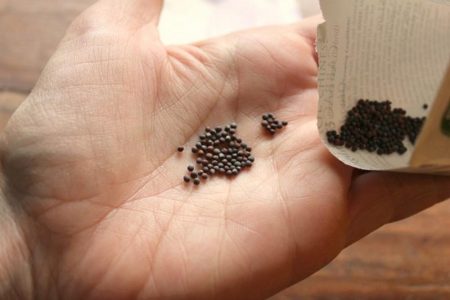 Seeds purchased at the store must not be sown immediately. Before sowing, you need to do the following work with them:
Seeds purchased at the store must not be sown immediately. Before sowing, you need to do the following work with them:
- calibrate
- warm up;
- to disinfect.
Having taken out the seeds from the bag, you need to pour them onto the table and examine. Only large and completed seeds are selected for sowing. Their embryos have greater growth power, seedlings of them are viable, which in the end gives a 30 percent increase in yield.
The next step in preparing the seed should be warming up. To do this, calibrated seeds are poured into a bag, which is placed in water heated to 50 degrees. After 20 minutes, the bag of seeds is removed and cooled for 2 minutes in iced water. Then the planting material is dried.
At the final stage of preparation, the seeds are etched with a formalin solution. When preparing a disinfecting solution, take 1 part of the drug per 300 parts of water. The operation is carried out by immersing the seeds in a solution of the drug for 60 minutes.
After dressing, the seeds can only be dried, after which they can be sown in the ground.
Sowing seeds for seedlings
Having prepared seeds on hand and waiting for the optimal time, you can directly proceed to sowing. Even before sowing seeds, the soil needs to be slightly moistened and leveled. On the leveled surface mark where the rows of plants will pass and make shallow grooves along these lines.
Landing depth
The seeds of the cabbage are small, so it is not recommended to close them deeply. If the depth is too deep, the achene may not have enough strength to ascend. The depth of planting grooves, as well as the depth of seeding, is taken 5-7 mm.
Sowing pattern
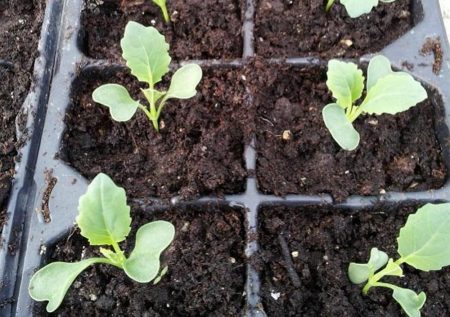 Cauliflower seeds are placed according to the scheme 3 by 1 cm. This means that the rows of plants in the box will pass every 3 cm, and in the sowing furrow, the seeds need to be laid out with an interval of 1 cm.
Cauliflower seeds are placed according to the scheme 3 by 1 cm. This means that the rows of plants in the box will pass every 3 cm, and in the sowing furrow, the seeds need to be laid out with an interval of 1 cm.
Then the seeds are covered with prepared soil composition and compacted. To get friendly and identical shoots, the boxes should be covered with plastic wrap. It should be removed when single seedlings appear on the surface of the soil.
Seedling growing technology
Many methods have been developed for growing cabbage seedlings. It is impossible to cover all of them in one article. We will dwell in detail on the method of growing with a pick and the method without picking. Both options, simple in essence, are suitable for home use.
Pick
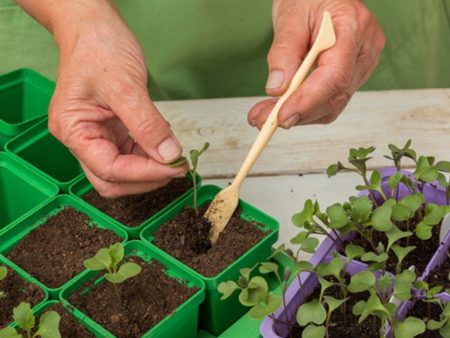 The meaning of this operation is to give the grown seedlings a large area of nutrition, compared with the one that he had before this procedure. Seedlings are not enough, therefore, at the first stage, seedlings in the box are placed quite densely. And while they are small, they get both nutrients and light.
The meaning of this operation is to give the grown seedlings a large area of nutrition, compared with the one that he had before this procedure. Seedlings are not enough, therefore, at the first stage, seedlings in the box are placed quite densely. And while they are small, they get both nutrients and light.
After 10 days, after the emergence of seedlings, the seedlings grow so much that it becomes crowded in the conditions in which it resides.
At this moment it is necessary to make a pick and to tighten with this operation it is impossible. When delayed with a dive, there are 2 negative points:
- seedlings shading each other, in search of light, can stretch out;
- growing seedlings become more fragile roots, which suffer greatly during transplantation.
As a result, seedlings transplanted late, poorly take root and are inhibited in development.
Pecking cabbage seedlings is better in peat pots. In this case, you will avoid repeated injury to the roots, as they will be planted on the bed with pots.Such seedlings take root and adapt to changing conditions much faster. Peat pots can be bought or made with your own hands.
Performing a pick, the plants are immersed in depth to the cotyledon leaves. Having completed the dive affairs, it is necessary to mulch the plants with ash or dry sand.
It is advisable that after the end of the procedure, you still have a supply of seedlings for replanting fallen plants.
Without pick
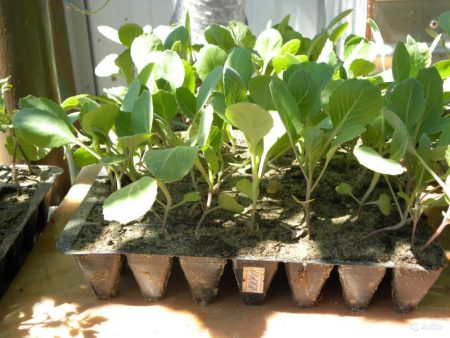 Growing cabbage seedlings does not have to include a technique such as picking. The pick-free method is gaining popularity. Using it, you can also eventually grow quite suitable seedlings.
Growing cabbage seedlings does not have to include a technique such as picking. The pick-free method is gaining popularity. Using it, you can also eventually grow quite suitable seedlings.
Adhering to this method, sowing seeds is done directly in peat pots, and the whole process of growing takes place in them. This method is especially suitable for growing late varieties of this vegetable, when cabbage plants are transplanted to the garden in early summer. The roots, while slightly injured, remain an earthen lump on the roots, which contributes to the rapid survival of seedlings.
Late cabbage seedlings are also grown directly on the bed. In order for seedlings to get food and light during growth, the seeds are sown according to the scheme 55 by 10 cm. The care of seedlings in the garden is no different from the care of seedlings that are cultivated in boxes or pots.
In order to protect the seedlings from night frosts and cold winds, arcs are placed over the bed and a plastic film is pulled over them. Young cabbage seedlings have enough heat and light to develop normally and meet all the requirements for good seedlings.
Care
Caring for cultivated seedlings consists of the following important tasks:
- top dressing;
- watering;
- maintaining the temperature regime;
- hardening.
All these works are carried out in a complex, taking into account the requirements and recommendations, otherwise it will be difficult to grow good planting material.
Fertilizer
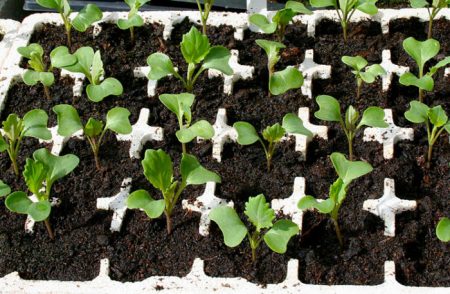 The roots of this cabbage, in comparison with white cabbage, are less developed and go deeper into a shallower depth. In the process of growing, seedlings must be fed at least twice with mineral fertilizers.
The roots of this cabbage, in comparison with white cabbage, are less developed and go deeper into a shallower depth. In the process of growing, seedlings must be fed at least twice with mineral fertilizers.
The first foliar top dressing is performed in phase 2 of these leaves. The working solution is prepared as follows:
- take 1 liter of warm water;
- 1/2 teaspoon of complex fertilizers is dissolved in this volume of liquid;
- after mixing, the solution is ready for use.
The prepared solution is treated with seedlings.
The second foliar top dressing is started approximately 12 days after the first. To do this, first prepare a working solution:
- in a bucket of water at room temperature dissolve 1 tbsp. l urea
- add to the composition of 1 tbsp. l potassium sulfate;
- mix the composition until the ingredients are completely dissolved.
The prepared solution is the processing of seedlings on the leaves.
Quenching
The hardening operation is designed to produce seedlings that are strong and resistant to cold. It begins to be carried out 13 days before the placement of seedlings on garden beds.
The essence of hardening is that in the spring on warm days, seedlings growing in boxes or in pots are taken out onto a loggia or in an unheated greenhouse, where the temperature is +5 degrees. At night, cold time, it is brought back into a warm room.
6 days before planting, they begin to leave it in the greenhouse and at night. If warm weather sets in the afternoon, you can open all the doors and windows in the greenhouse in order to maximize bring the conditions for growing cabbage to those that are waiting for it in the garden.
After a two-week hardening, seedlings are planted on vegetable beds in the open.
Watering
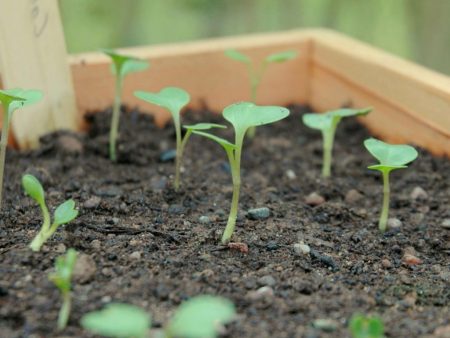 An important and responsible part of the care of seedlings is watering. Watering should be moderate, as excessive watering can cause the development of diseases.And due to insufficient watering, dwarf heads can form in cabbage.
An important and responsible part of the care of seedlings is watering. Watering should be moderate, as excessive watering can cause the development of diseases.And due to insufficient watering, dwarf heads can form in cabbage.
There are no differences between watering cauliflower and white cabbage. Watered with water at room temperature, after drying of the soil. To maintain optimum soil moisture, it is enough to produce 1 watering every 3 days.
8 days before the seedlings are planted, they stop being watered. Before removing seedlings, in order to less damage the roots, the soil under it is abundantly irrigated.
Too frequent irrigation or too high irrigation rates can cause seedling to become infected with a black leg.
Temperature for successful cultivation
Well, of course, to get good and healthy seedlings, you will need to strictly observe the requirements of the temperature regime. In the process of growing seedlings, the temperature will not be the same, since different phases of seedling development require different temperatures.
- In order for the seeds to hatch together, they hold a temperature of +20 degrees until germination. If the seeds are sown in a greenhouse, straw mats or old blankets are placed in the evening to keep the process temperature at night, on top of the film or glass frames.
- If, after germination, the seedlings fall into conditions with a high temperature, they will stretch and become thinner. Good seedlings, however, will not work. Therefore, after the seedling phase, the temperature in the nursery is sharply reduced to +8 degrees during the day and 2 degrees less at night. This temperature regime is kept for 7 days, this will allow you to get seedlings with thick and strong stems.
- Then the temperature is increased to 12 degrees and keep this temperature until a dive.
- After the picking procedure, the temperature can be increased by another 6 degrees, maintaining daytime at 18 degrees, and at night 16 degrees.
Planting seedlings on a garden bed
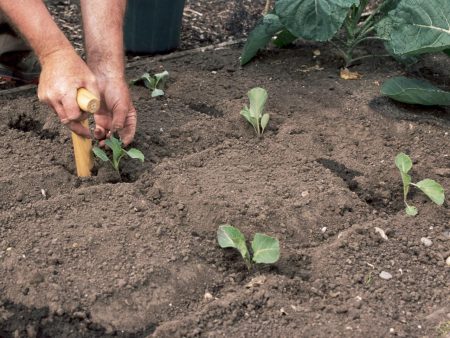 In order to properly plant the seedlings of this vegetable on the garden bed, the soil is prepared in the fall. After harvesting the predecessor, the bed is dug up by 25 cm, simultaneously cleaning out the rhizomes of perennial weeds and plant debris from the beds.
In order to properly plant the seedlings of this vegetable on the garden bed, the soil is prepared in the fall. After harvesting the predecessor, the bed is dug up by 25 cm, simultaneously cleaning out the rhizomes of perennial weeds and plant debris from the beds.
Under the autumn digging, it is necessary to introduce humus, at the rate of 8 kg per m2. In winter, it would be wise to push snow on the bed so that in spring, when it melts, it nourishes the bed with moisture.
In spring, shortly before planting, fertilizer is distributed on each m2 of beds in the following volumes:
- ammonium nitrate - 30 g;
- potassium chloride - 20 g;
- superphosphate - 50 g.
After spreading the fertilizers on the same day, the beds should be dug up, carefully breaking the earth clumps.
For seedlings, dig holes to a depth slightly higher than the height of the pots. Planting scheme depends on the precocity of the variety:
- early cabbage planted according to the scheme 70 to 25 cm;
- varieties belonging to the mid-season group are planted according to the scheme 70 by 30 cm;
- late varieties are placed according to the scheme 70 by 40 cm.
At the time of planting seedlings in a hole put 10 g of ash, after mixing it with the ground. Then 1 liter of water is poured into the hole and plants are planted. Seedlings in pots or without them, buried in the ground to 1 real leaf. At the final stage, it is necessary to water the planted seedlings well. For better survival, seedlings for 3 days are recommended to be shaded from the scorching sun.
After 6 days, planting is audited, the fallen plants are replaced with new ones. Next, you will need to land in a timely manner:
- to water;
- to feed;
- weed;
- spud.
Advice
For beginner gardeners, tips and tricks from experienced vegetable growers on caring for seedlings cultivated in the home can be useful. Read them:
- Wetting the soil before germination. During the first 5 days, from the day of sowing the seeds, drip water or use a spray bottle. The box with seedlings at this time should be in a room with a constant temperature of 19 degrees heat.
- When the first shoots hatch, transfer the box to another room where the temperature is maintained plus 8 degrees. If you continue to keep it at the same high temperature, the seedlings will stretch unnecessarily and may fall to the ground.
- Timely pick. If your seedlings are sown densely and you are late with a pick, then there is no reason to hope for good seedlings. With a lack of light and nutrition, she also faces stretching and thinning.
- The first feeding. It is carried out in phase 2 of real leaves in cabbage seedlings with a complex mineral fertilizer, dissolving 10 g of fertilizer in 1 liter. water. Top dressing is performed by spraying. So nutrition from fertilizer will be absorbed by both the roots and leaves of plants.
- The second spraying. The following dressing is performed after 12 days. The nutritional composition may be different. Suitable, for example, such a composition:
- 0.2 g of boric acid;
- 0.15 g of ammonium molybdenum acid;
- 0.15 g of copper sulfate.
All components are dissolved in 1 liter of warm water and sprayed.
- The third top dressing. It is carried out in a non-root way, when the head of cabbage becomes comparable to a walnut. This time they prepare such a solution, spending 1 cup for each plant:
- water - 10 l;
- potassium sulfate - 1 tbsp. l .;
- urea - 1 tbsp. l
Cultivation of seedlings at home, and then its transfer to the open ground, are available to everyone. It is only necessary to strictly follow the requirements of technology. The main points of the technology are: meeting the timing of sowing and planting, preparing the right soil mixture and watering, carried out when it is really needed.

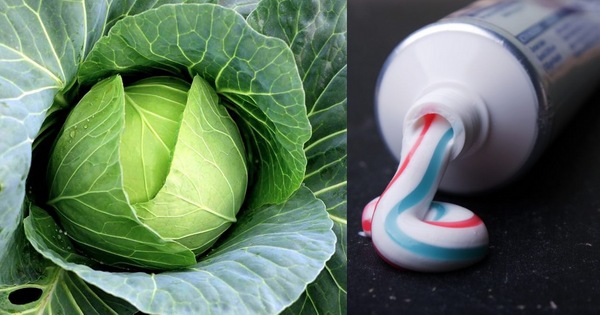
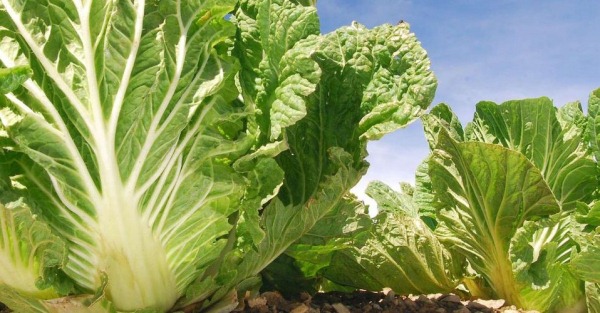
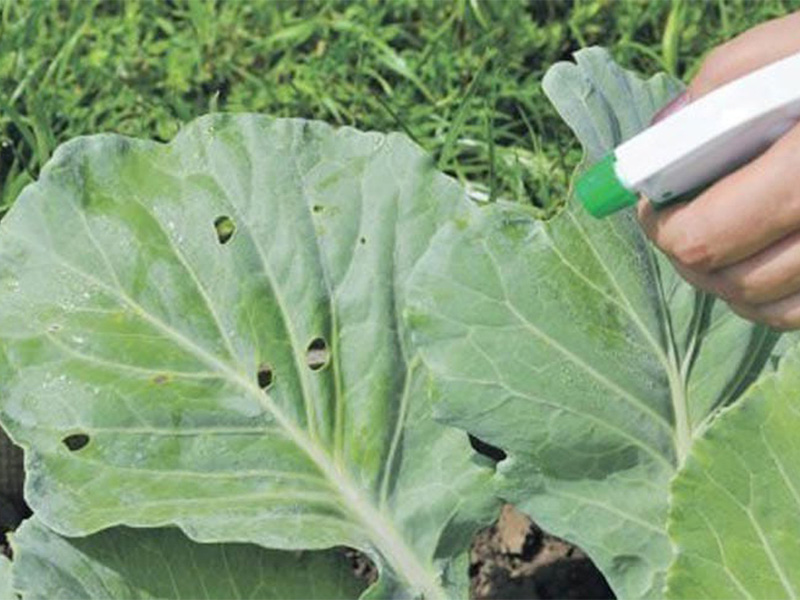
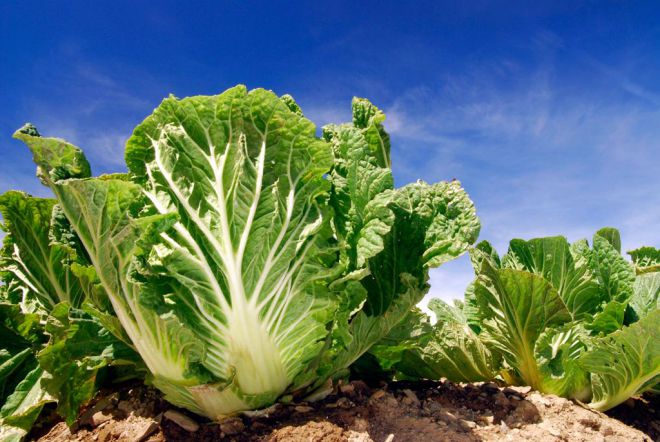 How to grow Chinese cabbage on your site?
How to grow Chinese cabbage on your site?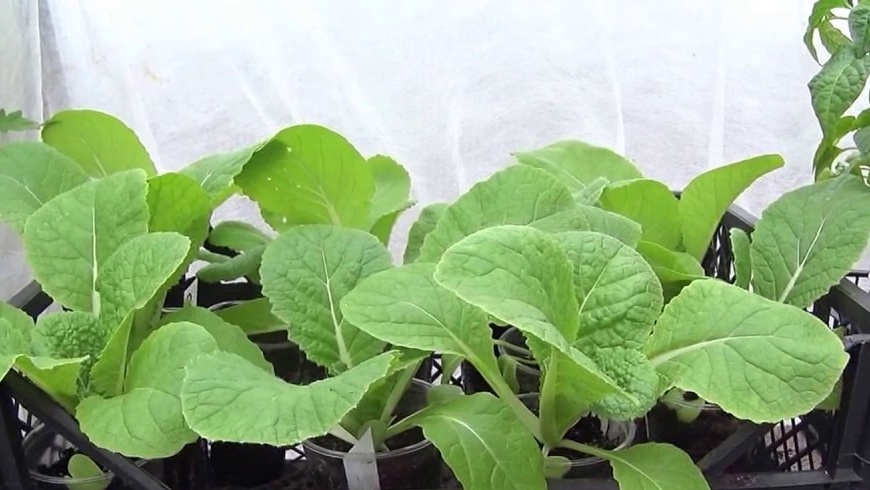 When to plant Chinese cabbage on seedlings in 2024
When to plant Chinese cabbage on seedlings in 2024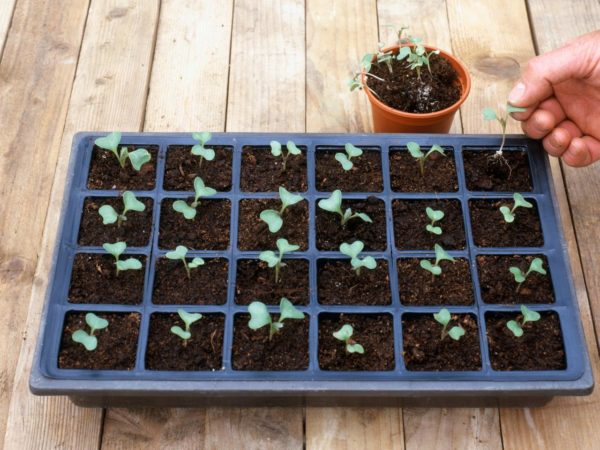 When to sow cabbage for seedlings in 2019 on the moon
When to sow cabbage for seedlings in 2019 on the moon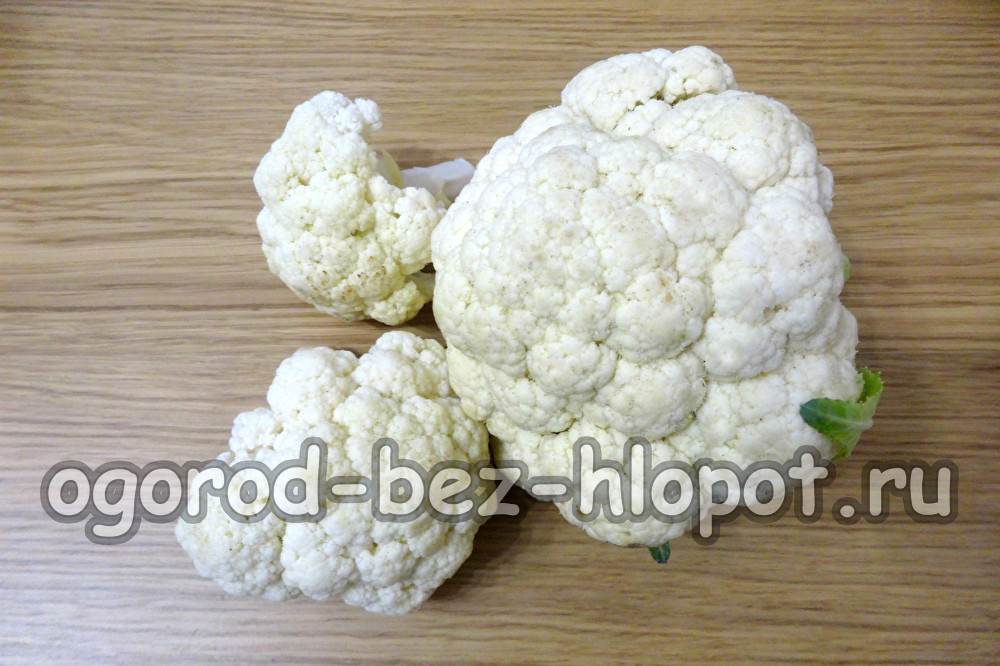 Cauliflower: how to grow large snow-white inflorescences
Cauliflower: how to grow large snow-white inflorescences